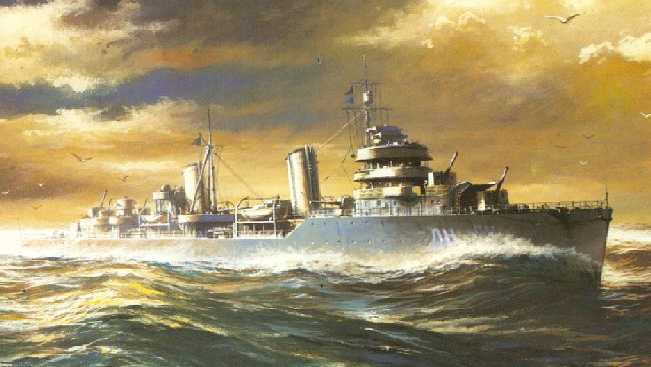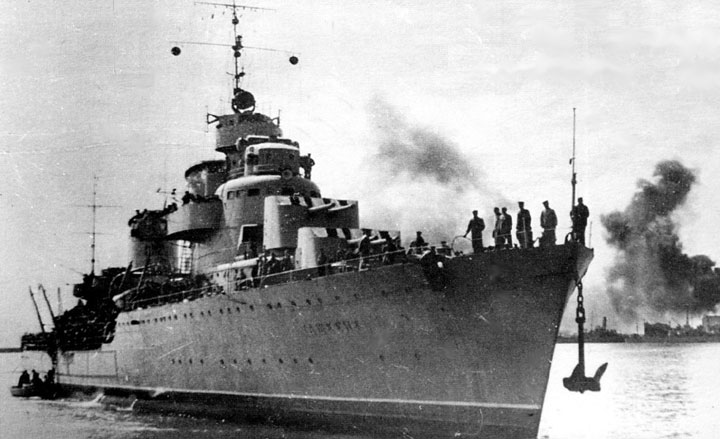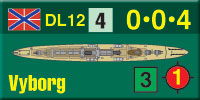The Cruel Sea:
Russian Destroyer Leaders
by Mike Bennighof, Ph.D.
August 2019
 In our Second Great War alternative-history story arc, Imperial Russia has survived the Great War and been spared the horrors of Revolution and Civil War. The empire remains a dreary place of few civil liberties under an authoritarian regime, with a massive war machine built to overturn and re-write the peace forged by Woodrow Wilson in 1917. In our Second Great War alternative-history story arc, Imperial Russia has survived the Great War and been spared the horrors of Revolution and Civil War. The empire remains a dreary place of few civil liberties under an authoritarian regime, with a massive war machine built to overturn and re-write the peace forged by Woodrow Wilson in 1917.
While the Imperial Army has received the bulk of the funds unleashed by explosive economic growth, the Navy has not been neglected. The struggle of Tsar Alexei’s Arctic Fleet (along with France’s Marine Nationale) against the Imperial German High Seas Fleet is the subject of our Second Great War at Sea: The Cruel Sea expansion set. Along with an alternative history and an alternative naval campaign, we have alternative fleets with alternative ships.
Russian ships in the Second Great War are based on both Imperial Russian and Soviet design practice; most of them are taken directly from Soviet design proposals and modified somewhat (most of the leading Soviet naval architects got their start under the Tsar, though the design bureaus suffered heavily under Stalinist political purges).
Imperial Russia revolutionized destroyer design with the boat Novik, designed by a German firm and completed in a Russian shipyard in 1913. The Russians would go on to lay down 52 more boats to the same design, with some improvements along the way. Novik was the fastest warship in the world when commissioned, half against as large as what other navies considered a “big” destroyer with a far heavier gun and torpedo armament.
The Soviet Red Navy inherited many of these boats but had no cruisers suitable to lead flotillas of them, and sought a new category of ship called lideri. The new ship should have a heavier armament, to challenge enemy destroyers outside their own gunnery range, be faster than a destroyer, and large enough to accommodate the flotilla commander’s staff and the associated communications gear.
Other nations built “leaders” as well, including Britain (which went with slightly enlarged versions of standard destroyer classes) and the United States (which built larger boats intended to serve as leaders, but then deployed them in the same roles as any other destroyer). The Japanese used their older light cruisers in the destroyer-leader role.

Pretty picture, pretty poor design: the destroyer leader Leningrad.
The first new warship designed under the Soviet regime, the Project 1 destroyer leader, was the centerpiece of the First Five Year Plan’s naval building program. Project 1 (the Leningrad-class destroyer leader) was loosely based on the French large destroyers known as contre-torpilleurs, large vessels intended as “destroyers of destroyers.” In service they turned out to be top-heavy, unbalanced with too much weight forward and hard to steer at speed. They also carried a main armament of poorly-made 130mm guns that wore out after fewer than 200 shots (less than the ship’s ammunition load).
Following that failure, the Soviets turned to the Italians for assistance, and purchased a ship from the Oderno-Terni-Orlando combine that they named Tashkent. She would be the only large warship built aboard to see service in the Red Navy (a cruiser purchased from Germany would never be completed) and proved extremely successful. But Soviet shipyards proved unable to reproduce the technically sophisticated vessel, and the Red Navy opted for a smaller, less capable design derived from Tashkent. The Royal Italian Navy would develop the design into its own class of small, ultra-fast light cruisers known as the “Capitani Romani” class.
Tashkent, known in the Red Navy as the “Blue Beauty” from her fine lines and sky-blue paint scheme, served very actively in the Black Sea until suffering fatal damage in a June 1942 air attack. Like other ships of the Black Sea Fleet, she provided fire support to the Red Army and shuttled troops and wounded between besieged ports like Odessa and Sevastopol and safer bases in the eastern Black Sea. She did not have an opportunity to engage the Romanian destroyer flotilla and was never tested in surface combat.

The Black Sea Fleet’s “Blue Beauty,” the destroyer leader Tashkent.
In our alternative history, the Imperial Russian Navy has maintained its tradition of building big destroyers, and as the old Novik-class boats age the fleet begins to acquire both new destroyers and leaders for the flotillas. As in our own history, an Italian-built model is acquired, this time named Samarkand. Unlike our own history, Russian shipyards – at the forefront of the Empire’s massive industrial expansion – are well able to build more of them. Many more of them.
Samarkand is slightly larger than Tashkent, on which she is modelled, with a heavier armament. She carries six Italian-made 135mm (5.3-inch) Model 1938 guns in three twin dual-purpose mounts and nine torpedo tubes in three triple mounts placed along the centerline. She has the full anti-submarine suite of a destroyer (sixty depth charges, with two throwers and two stern-mounted racks) and can carry and lay up to forty mines.
The Model 1938 was a serviceable weapon, that remained in Italian service until the late 1960’s. It had good accuracy, but a usable anti-aircraft mount was not available until after the war. Samarkand has a Russian-designed mount that allows for auto-loading at all angles, though aircraft are not yet a serious threat to surface ships in the world of the Second Great War.
Like Tashkent, Samarkand has a huge power plant making 110,000 horsepower to drive two shafts, good for 40 knots (the Italian Littorio-class fast battleships produced 128,000 horsepower). She carries no armor protection. While designed as destroyer leaders, the boats sometimes operate with others of their class and fill some cruiser roles. They are formidable opponents in surface combat, giving the Russians a more capable boat than the German Storm Bird type destroyers. Unlike the formidable Storm Birds, however, they don’t usually appear in large flocks.
 Unlike cruisers and larger warships, the number of destroyers isn’t limited by arms control agreements in our alternative history (as they were in our actual history) though there are size limits. For the Russians, attempting to equip four separate fleets that can’t reinforce one another during wartime, the big destroyer leader is an attractive means to increase the strength of their surface forces. Unlike cruisers and larger warships, the number of destroyers isn’t limited by arms control agreements in our alternative history (as they were in our actual history) though there are size limits. For the Russians, attempting to equip four separate fleets that can’t reinforce one another during wartime, the big destroyer leader is an attractive means to increase the strength of their surface forces.
By the summer of 1940, the Imperial Navy has 24 of them in service, with a dozen more under construction. We included six examples in The Cruel Sea, and four more in Swedish Steel. The Pacific Fleet has more of them than the other contingents, to help off-set combat power of the Japanese “Special Type” destroyers.
You can order The Cruel Sea right here, right now.
Sign up for our newsletter right here. Your info will never be sold or transferred; we'll just use it to update you on new games and new offers.
Mike Bennighof is president of Avalanche Press and holds a doctorate in history from Emory University. A Fulbright Scholar and NASA Journalist in Space finalist, he has published over 100 books, games and articles on historical subjects.
He lives in Birmingham, Alabama with his wife, three children and his dog, Leopold.
|
